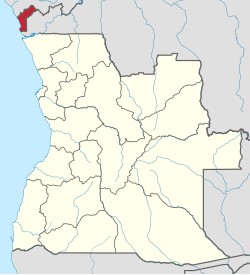
Back Cabinda (provinsie) Afrikaans مقاطعة كابيندا Arabic Provincia de Cabinda AST AngolaCabindaWinka AVK Kabinda Azerbaijani Кабінда (правінцыя) Byelorussian Кабінда (правінцыя) BE-X-OLD Кабинда Bulgarian Kabinda Breton Província de Cabinda Catalan
Cabinda | |
|---|---|
 Cabinda, exclave of Angola | |
| Coordinates: 4°56′03″S 12°24′19″E / 4.93417°S 12.40528°E | |
| Country | Angola |
| Alvor Agreement | 15 January 1975 |
| Capital | Cabinda |
| Government | |
| • Governor | Eugénio César Laborinho[1] |
| • Vice-Governor for the Economical Sector | Macário Romão Lembe |
| • Vice-Governor for the Political and Social Sector | Alberto Paca Zuzi Macosso |
| • Vice-Governor for Technical Services and Infrastructures | Joaquim Dumba Malichi |
| Area | |
• Total | 7,290 km2 (2,810 sq mi) |
| Population (mid-2019) | |
• Total | 824,143 |
| ISO 3166 code | AO-CAB |
| HDI (2022) | 0.688[2] medium · 2nd |
| Website | www |

Cabinda (formerly called Portuguese Congo, Kongo: Kabinda) is an exclave and province of Angola, a status that has been disputed by several political organizations in the territory. The capital city is also called Cabinda, known locally as Tchiowa, Tsiowa or Kiowa.[3] The province is divided into four municipalities—Belize, Buco-Zau, Cabinda and Cacongo.
Modern Cabinda is the result of a fusion of three kingdoms: N'Goyo, Loango and Kakongo. It has an area of 7,290 km2 (2,810 sq mi) and a population of 716,076 at the 2014 census; the latest official estimate (as at mid-2019) is 824,143. According to 1988 United States government statistics, the total population of the province was 147,200, with a near even split between rural and urban populations.[4] At one point an estimated one third of Cabindans were refugees living in the Democratic Republic of the Congo;[5] however, after the 2007 peace agreement, refugees started returning to their homes.[6]
Cabinda is separated from the rest of Angola by a narrow strip of territory belonging to the Democratic Republic of the Congo (formerly known, up until 1960, as the Belgian Congo), which bounds the province on the south and the east. Cabinda is bounded on the north by the Republic of the Congo (formerly known as French Congo), and on the west by the Atlantic Ocean. Adjacent to the coast are some of the largest offshore oil fields in the world.[7] Petroleum exploration began in 1954 with the Cabinda Gulf Oil Company, when the territory was under Portuguese rule.[8]
Cabinda also produces hardwoods, coffee, cacao, rubber, and palm oil products; however, petroleum production accounts for most of Cabinda's domestic product. Cabinda produces 700,000 barrels (110,000 m3) of crude oil per day.[when?] Cabinda Oil is associated with Sonangol, Agip Angola Lda (41%), Chevron (39.2%), TotalEnergies (10%) and Eni (9.8%).
In 1885, the Treaty of Simulambuco established Cabinda as a protectorate of the Portuguese Empire, and Cabindan independence movements consider the occupation of the territory by Angola illegal. While the Angolan Civil War largely ended in 2002, an armed struggle persists in the exclave of Cabinda.[9] Some of the factions have proclaimed an independent Republic of Cabinda, with offices in Paris.
- ^ "Cabinda: Governor fires and appoints new officials". Agência Angola Press. 5 May 2016. Archived from the original on 20 August 2020. Retrieved 8 February 2017.
- ^ "Sub-national HDI – Area Database – Global Data Lab". hdi.globaldatalab.org. Archived from the original on 23 September 2018. Retrieved 26 February 2020.
- ^ André Gomes Capita Nionje, Arquitetura tradicional em Cabinda Comuna do Tando-zinze Aldeia de Lucula-zenze Cabinda-Angola, Universidade Lusófona de Humanidades e Tecnologias, 2019
- ^ Collelo, Thomas (editor) (1989) A Country Study: Angola Federal Research Division, Library of Congress, Washington, D.C., Appendix A, Table 2, Cabinda, Archived 2 March 1999
- ^ "Refugees from Angola's Cabinda enclave cautious about returning". United Nations High Commission for Refugees. 7 March 2005. Archived from the original on 19 December 2015. Retrieved 7 March 2005.
- ^ 2009 Human Rights Report: Angola United States State Department (11 March 2010) accessed 21 December 2023
- ^ "Sport and terrorism: A deadly game". The Economist. 11 January 2010. Archived from the original on 24 January 2010. Retrieved 11 January 2010.
- ^ Cabinda, Angola Archived 27 March 2009 at the Wayback Machine, ICE Case Studies Number 129, 2004 by Alan Neff
- ^ Ojakorotu, Victor (2011). "The Paradox of Terrorism, Armed Conflict and Natural Resources: An Analysis of Cabinda in Angoloa". Perspectives on Terrorism. 5 (3/4): 96–109. ISSN 2334-3745. JSTOR 26298526. Archived from the original on 25 June 2023. Retrieved 24 June 2023.

